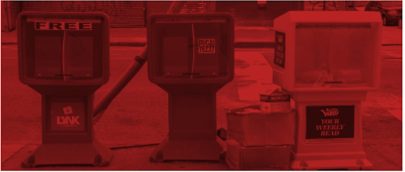Frequently Asked Questions: The LJSA and Local News Tax Credit
What is the Local Journalism Sustainability Act?
The Local Journalism Sustainability Act provides a series of tax benefits to consumers who subscribe to local news, small businesses who advertise in local publications and local publications that hire local journalists.
How big are the benefits?
Local residents could get a credit of up to $250 to buy a local news subscription or donate to a local nonprofit news organization. To earn the full benefit, consumers would need to put in 20 percent themselves in the first year and 50 percent in subsequent years.
Small businesses, which the Senate version of the bill defines as those with less than 50 employees, could get $5,000 to help pay for any advertising they place in local publications and $2,500 each of the remaining four years of the bill.
Most important, local publications would receive a refundable payroll tax credit of up to $25,000 for each journalist on staff. To be clear, this doesn’t merely reimburse them for what they pay in payroll taxes; the newsroom would actually get $25,000 from the government to help cover a reporter with a $50,000 salary. The bill defines a journalist as almost anybody involved in the production of local news, from photographers to reporters to editors. After the first year, publications could receive up to $15,000 per local journalist.
What is in the House version of the Build Back Better Act?
The payroll tax credit originally proposed in the Local Journalism Sustainability Act was included in the House of Representative’s latest version of the Build Back Better Act. You can read the text of the provision here.
Why the focus on the payroll tax credit?
The payroll credit is the most direct benefit to publishers. In the Coalition’s benefit estimations, the payroll tax credit accounted for 50% of the overall benefit publications would likely see if the entire Local Journalism Sustainability Act is passed. Including the payroll tax credit in the Build Back Better Act offers publishers a potentially transformative fund at a moment when they have been challenged by a pandemic and decades of financial free fall. It is the Coalition’s hope that the other two planks of the Local Journalism Sustainability Act — the small business credit and the subscription credit — will be passed in the future, but we applaud the inclusion of the payroll credit in the Build Back Better Act.
Do people have to itemize their taxes to get the benefit of the subscription or donation tax credit?
No. Because the benefits are in the form of a tax credit, not a tax deduction, subscribers do not have to itemize their taxes to receive the benefit. However, people who do not pay federal taxes, cannot take advantage of the credit.
Won’t the advertisers just use the money to buy ads on Facebook or Google?
They’re not allowed to. They only get the tax credit if they spend it on a local newspaper, website, TV or radio station or other entities providing local news.
How much does this mean for an individual newsroom?
Here’s a case study we did with the Baltimore Afro-American. They estimated they’d get between $109,000 and $196,000 in the first year — and as much as $852,000 over five years.
Payroll tax credit — With their current staffing, they would get $90,000. That would allow them to add four editorial positions, doubling the size of the newsroom.
Advertising credit — They would earn at least $10,000 in new small business advertising in the first year and $50,000 over five years if 20 small businesses took out even $500 in advertising. If those businesses took advantage of the full benefit ; $5,000 in the first year and $2,500 in the years thereafter ; it would mean a $300,000 boost.
Subscriptions — They estimate that it would bring in an additional $30,000 in new subscription revenue over five years.
Jim Friedlich, the President of the Lenfest Institute, estimated that a midsized news organization with 50 journalists would receive roughly $1 million in payroll tax credit to help retain local reporters, and he called the act “potentially the most important legislation for local news in the last hundred years.”
How long would the Local Journalism Sustainability Act last?
Five years
What does the bill mean by “newspaper”?
Although the bill says “newspaper,” it actually includes a wide range of local media, including local news websites, public radio stations that produce local reporting, local digital nonprofits, and local newspapers. In the Senate version of the bill, local TV and radio stations are also included.
Who supports the Local Journalism Sustainability Act?
The LJSA has attracted a broad coalition of support from within the industry. The NewsGuild, Institute for Nonprofit News, the Black publishers’ organization (National Newspaper Publishers Association ), National Association of Hispanic Publishers , community broadcasters, and Local Independent Online News (LION) Publishers among others have all backed the bill.
The groups represent local print newspapers, emerging digital startups, BIPOC media, family-owned operations and alternative media publications — plus philanthropic organizations trying to build local news, such as the American Journalism Project, the Lenfest Institute, the Solutions Journalism Network and Chalkbeat. (Full list here)
More recently, the National Association of Broadcasters, which represents local TV stations, has backed the Senate version of the bill (which enables TV stations to receive the payroll tax credit).
Do any national publications benefit from the bill?
This is a local news bill meant to support community journalism. To reap the benefits of the LJSA, publications must be focused on local news, and employ a local reporter. In addition, publications with more than 1,000 employees (i.e. national newspapers) are excluded.
However, national publications that have local journalism projects or subsidiaries could benefit.
Is it just Democrats pushing this bill?
No. The coauthor of the House bill is Rep. Dan Newhouse, a Republican Congressman from Washington state. In fact, last session the bill had 20 Republican cosponsors and the recently-introduced version already has 11. These Republicans understand the importance of local media and appreciate the bottom-up approach to providing the support. This piece by Washington Post columnist Margaret Sullivan explains why the bill has been pretty bipartisan.
It is true, however, that so far in the Senate the cosponsors have all been Democrats. We’re working on that!
When will it be passed?
The bill was introduced in the House in June and the Senate in July. There is real interest in Congress right now. But it will only get in there if people express their support to their local lawmakers.
How can I help?
We’d love to hear from you! If you have a question about what you can do to amplify our call to Congress to support the Local Journalism Sustainability Act or need additional resources or tools, please use our contact form to get in touch!
Where can I find the text of the bill?
Congressional staffers are still working on potential refinements. But the most recent version of the Senate bill is here while the House version is here.
Won’t this just help subsidize “the liberal media”?
This bill focuses on rebuilding local news, covering the nitty gritty issues of concern to all communities. That is a nonpartisan issue. What’s more, the government will not be making subjective decisions about who gets to benefit — so Republican administrations cannot steer money to conservative media; Democratic administrations cannot push it toward their favored publications. And the tax credits for subscriptions go to consumers — so they decide which local publication they prefer. The advertising tax credits go to small businesses — so they pick the local news outlets that would best help them achieve their goals.
Most local publications don’t hew to ideological agendas the way cable TV programs do. That said, there will no doubt be local organizations that benefit that you might personally dislike. That is true of the charitable deduction that supports a wide range of charities. But it would so strengthen democracy that it will be well worth us all putting up with some money going to some places we don’t like.
Won’t this fund “right wing” publications?
Same answer as above.
Isn’t it dangerous to have news organizations take money from the government?
It could be! That’s why we like the particular structure of this program. It follows the model of the postal subsidy program set up by the Founding Fathers — which was content neutral, providing financial help to newspapers on the basis of how far they were traveling. This bill envisions a minimal role for the government to decide who gets what. Rules are set — and then any publication that qualifies can benefit.
Will this help news organizations focused on communities of color?
Yes, we expect that media organizations covering communities of color could benefit profoundly. Unlike a discretionary grant program, which requires local media to be approved by officials at a government agency, this merely requires that the organization qualify. Do they cover their community? Do they have a local reporter? If they do, they get the benefit. For instance, the Baltimore Afro-American projects that it would be able to double its editorial staff with the benefits of the bill. Nationally, we expect that several hundred million dollars in help could go to local BIPOC news organizations — which would make it the largest federal program to help BIPOC media, well, ever.
Won’t all the money go to legacy media?
It is true that significant amounts of support will go to legacy media. That’s because the benefits are structured to go to organizations that currently employ local journalists. Right now, that’s mostly legacy media. But the bill is “future friendly” in that small entities that have just one local reporter can benefit. Even startups that don’t yet exist will be able to qualify as soon as they meet the requirements.
Can a brand new local news startup benefit?
We’re hoping the rules will stipulate that the organization need only to have existed for one year. (The current language in the two bills limits the benefits to any organization that has been operating for at least two; we’d like to see that shortened). In addition, with some creativity, foundations could set up funds to advance initial capital to startups using the future payroll tax benefits as collateral.
Does this include nonprofit news organizations?
Yes! Notably, because the aid for journalist employment is done through the payroll tax, nonprofits (which also pay payroll taxes) benefit too. In addition, Reps. Kirkpatrick and Newhouse added a provision, at our request, to make sure that the credit is not only for subscriptions, but also for donations to local nonprofit news organizations. The ad credit will also hopefully be defined to include sponsorships with nonprofits. That is why the Institute for Nonprofit News, the main organization representing nonprofit, digital publishers, strongly supports the legislation.
Why does the bill allow money to go to hedge funds?
The current bill does not distinguish good publishers from bad, large from small, urban from rural. It assumes there are news deserts and needs everywhere. Half of the daily circulation in America is now owned by hedge funds. That’s a deeply troubling trend. But it’s also the current reality ; so the authors of the bill concluded that for the communities affected, it’s better for those newspapers to have reporters than to not have reporters.
Isn’t this just a band aid that won’t truly help local news in the long run?
This bill incorporates some concepts that improve the long-term prospects of local journalism. First, local reporting is the key. For a while, there was a hope that algorithms, social media or crowdfunding alone would provide the information that communities need. That’s not true. We need reporters, too. The heart of the bill is providing a subsidy to help hire and retain local journalists. Doing better reporting will make it more likely for startups to get traction and legacy media to better serve their communities.
Second, it’s become clear that local news must reduce its dependence on advertisements and grow their digital subscription revenue. The subsidy for buying subscriptions could help accelerate this transition to a more subscription-based model.
Third, this gives a huge boost to the nonprofit local news world. With help, they could become a much bigger part of local news ecosystems, especially where there are news deserts.
Aren’t most small media too poor to take advantage of this program?
The bill currently requires only that you have one reporter. (Actually, the current versions only require 100 hours per quarter of local journalism; but we’re hoping that gets changed to a requirement for one full time reporter.) And the definition of journalist includes editors. So most of even the smallest local media should be able to participate.
Could so-called “pink slime” organizations misuse the program?
This has been a topic of much conversation among the people working on this issue. The last thing we’d want is to unintentionally fuel misinformation from fake or disreputable websites. The bill includes a number of safeguards. The most important is that they have to be doing local reporting — and employ actual local reporters. Most of the fake news sites do not have local reporters. The bill would be stronger if it also excluded sites run by 501c4 advocacy organizations and required that they carry liability insurance.
What are the differences between the Senate bill and the House bill?
The House bill provided three tax credits, but was focused on websites and newspapers. The Senate bill brought broadcasters into the bill (both commercial and public broadcasting). However, when the House Ways & Means Committee passed their version of the budget plan, they dropped the subscription and advertising tax credit, and included just the payroll tax credit, without the broadcasters. The Senate is now considering whether to follow the same approach as the House or add back the broadcasters and the other two credits.
Who introduced the bill?
The bill was first introduced by Rep. Ann Kirkpatrick (D-AZ) and Rep. Dan Newshouse (R-WA), and has since attracted a wide spectrum of cosponsors with 11 Republicans and 35 Democrats supporting the act.
Sen. Maria Cantwell (D-WA) , Sen. Ron Wyden (D-OR), and Sen. Mark Kelly (D-AZ) introduced the Senate version of the bill. Notable cosponsors also include Sen. Joe Manchin (D-WV) and Sen. Amy Klobuchar (D-MN), who has been a longtime advocate for policies that support the local press. Sen. Cantwell also sits on the Senate Finance Committee, where the bill will be considered and Sen. Wyden serves as the committee’s chair.
What are the limitations of the bill?
In the current bills, the language defining eligible local news organizations is too vague and subjective. It needs to be a bit more precise, or else some organizations that are not really focused on local news might sneak in. The subscription credit would be more equitable if it were “refundable” so that the lowest income people — those who don’t pay federal income taxes — could also use the credit.
Beyond that, there are many problems with local news that this bill does not address. For instance, mainstream media has a horrible historic track record of inaccurate, unfair and sometimes downright racist coverage of communities of color. This bill doesn’t solve that (though it will empower local publications covering communities of color to tell their own stories). Nor does this bill address the problems created by the consolidation of the local news companies (though it does provide help to little guys). These issues need to be addressed.
Why not a grant program?
There are several advantages to structuring help for local news as a tax credit program rather than a grant. This gets a bit wonky, so hang in there for a poli-sci digression. Most grant programs are funded by a Congressional appropriation. It’s a fixed pot of money. If one newsroom gets more, then other newsrooms get less. A tax program operates more like an entitlement — if you’re eligible, you get it. One newsroom getting a benefit doesn’t mean your newsroom gets less. And by the way, the overall pot is almost certainly going to be smaller via a grant program than if it’s through a tax program. So a tax program is likely to provide far more help to local news, most likely by orders of magnitude.
In addition, a grant program has to be administered by a government agency. That means we’d need to have a system of government officials making discretionary judgments about which newsrooms get what. In theory, one could set up firewalls that would protect the editorial independence, but it would be harder.




